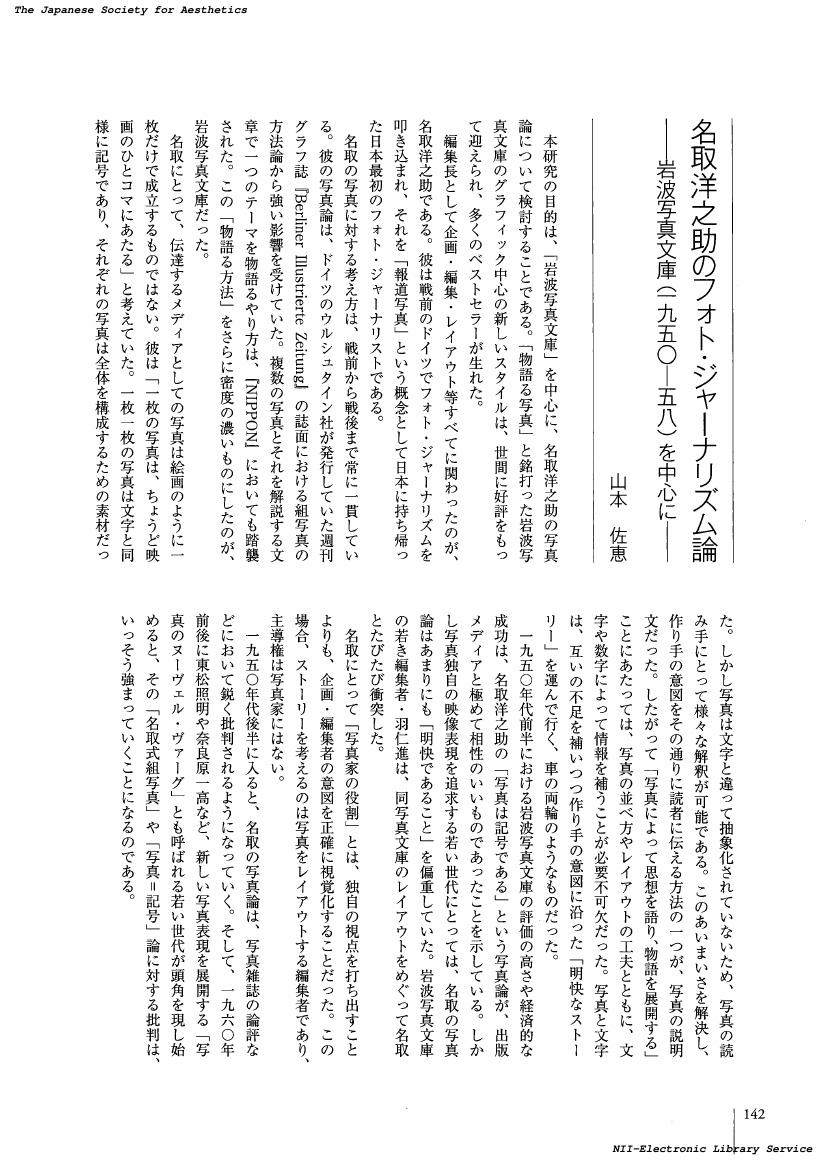2 0 0 0 OA 一九五〇年代の田中一光作品における「日本的なもの」の表現
- 著者
- 山本 佐恵
- 出版者
- 美学会
- 雑誌
- 美学 (ISSN:05200962)
- 巻号頁・発行日
- vol.68, no.1, pp.85-96, 2017 (Released:2018-07-01)
Ikko Tanaka (1930-2002) was a distinguished Japanese graphic designer in postwar Japan. Representations of his design works are diverse. However, the theme of “Japanese tradition” or “Japaneseness” is present consistently in Tanaka’s unique expression in his works. This paper examines the representation of “Japaneseness” of Tanaka’s works in the context of postwar graphic design circles. Tanaka’s design for the “Exhibition of Japanese Textiles at Takashimaya in New York (1959),” which utilized only “kanji (Chinese characters) typography,” has been evaluated by a Western sense of modern design as a work that expressed Japanese traditional culture. Without relying on Japanese motifs such as Mt.Fuji, Japanese cherry, or “geisha”, this is an epoch-making work that expresses “Japaneseness” only through kanji; it is one of the masterpieces in Japanese graphic design history. In this work, Tanaka created “the originality of Japanese Design” by a method of constructing into the design while taking advantage of the function of kanji ideograms. In order to shed the imitation of Western design, Tanaka represented “Japaneseness” by adopting the “zure (gap)” and “kasure (scratchiness)”, which departed from modern design theory, and by devising a new color scheme.
2 0 0 0 OA ニューヨーク万国博覧会と工芸 : 文化宣伝と輸出振興
- 著者
- 山本 佐恵
- 出版者
- Seminar on History of Art, Graduate School of Comprehensive Human Sciences, University of Tsukuba
- 雑誌
- 藝叢 : 筑波大学芸術学研究誌 = Bulletin of the study on philosophy and history of art in University of Tsukuba (ISSN:02894084)
- 巻号頁・発行日
- vol.23, pp.61-87, 2007-03-01
著作権保護のため、すべての掲載図版に墨消し処理を施しています。
2 0 0 0 OA サンフランシスコ万国博覧会日本古美術展覧会(一九三九年) : 美術展示と植民地
- 著者
- 山本 佐恵
- 出版者
- Seminar on History of Art, Graduate School of Comprehensive Human Sciences, University of Tsukuba
- 雑誌
- 藝叢 : 筑波大学芸術学研究誌 = Bulletin of the study on philosophy and history of art in University of Tsukuba (ISSN:02894084)
- 巻号頁・発行日
- vol.24, pp.133-158, 2008-03-01
著作権保護のため、すべての掲載図版に墨消し処理を施しています。
2 0 0 0 OA ニューヨーク・サンフランシスコ万博(1939-1940)における「日本」表象の研究
- 著者
- 山本 佐恵
- 巻号頁・発行日
- 2010
筑波大学博士 (芸術学) 学位論文・平成22年3月25日授与 (甲第5448号)
2 0 0 0 OA 1940年ニューヨーク万博に出品された写真壁画《日本産業》にみる「報道写真」の影響
- 著者
- 山本 佐恵
- 出版者
- 一般社団法人 日本デザイン学会
- 雑誌
- デザイン学研究 (ISSN:09108173)
- 巻号頁・発行日
- vol.56, no.2, pp.63-72, 2009-07-31 (Released:2017-06-29)
- 参考文献数
- 64
1940年のニューヨーク万博の展示館「カヴァード・スペース」に、日本は写真壁画《日本産業》を展示した。それは「造船」、「手工芸」、「紡績」、「機械工」、「航空」というテーマの5面から構成され、写真のモンタージュに加え、写真への着色や、金属、絣綿布、木綿紐、ガラス、加工ベニヤ板等を写真に組み合わせて構成するなど、造形的処理が施されていた。こうした手法は、欧米の模倣や追従ではない独自の表現方法として、当時、日本の批評家から高く評価された。《日本産業》に使われた写真は、土門拳など当時の新進写真家たちが撮影した「報道写真」だった。5面を連結させて一つのテーマを構成する方法は、「報道写真」における「組写真」の形式にならったものだった。その背景には、当時ドイツから移入された新即物主義と、そこから生まれた「リアル・フォト」の表現があった。また、報道写真家パウル・ヴォルフの写真から、構図や表現に多くの示唆を受けた可能性が指摘できる。
2 0 0 0 OA 1930年代の万博における写真壁画とフォトモンタージュ
- 著者
- 山本 佐恵
- 出版者
- 一般社団法人 日本デザイン学会
- 雑誌
- 日本デザイン学会研究発表大会概要集 日本デザイン学会 第56回研究発表大会
- 巻号頁・発行日
- pp.E13, 2009 (Released:2009-06-16)
日本は1930年代の万博で、当時「写真壁画」と呼ばれた巨大な写真パネルを展示した。写真壁画の様式には、それぞれ独立した小テーマを持つ写真壁画を複数面連続してつなげ、全体として一つの大きなテーマを構成する「組写真」形式と、様々な写真や図案を同じ画面上に貼り込む「コラージュ」形式がある。本発表では、後者の「コラージュ」形式のものについて発表する。原弘が構成した《観光日本》(1937年パリ万博)、山脇巌が構成した《観光日本》(1939年ニューヨーク万博)、亀倉雄策が構成した《楽しい日本》(1940年サンフランシスコ万博)の3点を取り上げる。 各写真壁画を構成する際、建築家の山脇の場合は会場の展示空間との兼ね合いを念頭におきながら、壁面装飾の一部として制作した。一方図案家の原は、写真壁画を「一枚の大きな観光ポスター」と捉え、広告としての役割を意識して制作した。同じく図案家の亀倉は、バウハウスやヘルベルト・バイヤーなどのフォトモンタージュ技法から多くの影響を受け、それらの技法を自身の写真壁画制作に取り入れた。本発表では、これらの写真壁画の制作の背景と、構成内容の特徴について報告する。
1 0 0 0 OA 1950年代の田中一光における前衛美術の影響
- 著者
- 山本 佐恵
- 出版者
- Japanese Society for the Science of Design
- 雑誌
- 日本デザイン学会研究発表大会概要集
- 巻号頁・発行日
- pp.98, 2015 (Released:2015-06-11)
本研究の目的は、田中一光(1930-2002)のデザイン活動の初期にあたる1950年代に焦点をあて、田中における前衛美術の影響について考察することである。彼が青年期を過ごした関西では、 グラフィックデザイナーは美術家と活発に交流し、独自の美意識やデザイン感覚を発展させた。 事実、田中に強い影響を与えたのは早川良雄と吉原治良であることはよく知られている。 50年代の田中の活動においては舞台美術も重要であり、吉原が舞台美術を担当した52年の国際ファッションショーでは助手を務め、また吉原が主宰した具体美術協会が57年に開催した「舞台を使用する具体美術」の大阪公演では演出助手を務めている。さらに注目すべきは、吉原によって前衛書道への開眼に導かれた点である。森田子龍が創刊した『墨美』を吉原から何度か借りたことで、田中は前衛書道に関心を持つようになる。前衛書道の造形は田中に刺激を与え、後に制作したシルクスクリーン作品やモリサワのポスターなどに興味深い類似性がみられる。前衛書道への開眼は、田中がグラフィックデザインにおけるカリグラフィやタイポグラフィの効果について研究する上で役立ったと推測される。
1 0 0 0 1950年代の田中一光における前衛美術の影響
- 著者
- 山本 佐恵
- 出版者
- 日本デザイン学会
- 雑誌
- 日本デザイン学会研究発表大会概要集
- 巻号頁・発行日
- vol.62, 2015
本研究の目的は、田中一光(1930-2002)のデザイン活動の初期にあたる1950年代に焦点をあて、田中における前衛美術の影響について考察することである。彼が青年期を過ごした関西では、 グラフィックデザイナーは美術家と活発に交流し、独自の美意識やデザイン感覚を発展させた。 事実、田中に強い影響を与えたのは早川良雄と吉原治良であることはよく知られている。<br> 50年代の田中の活動においては舞台美術も重要であり、吉原が舞台美術を担当した52年の国際ファッションショーでは助手を務め、また吉原が主宰した具体美術協会が57年に開催した「舞台を使用する具体美術」の大阪公演では演出助手を務めている。さらに注目すべきは、吉原によって前衛書道への開眼に導かれた点である。森田子龍が創刊した『墨美』を吉原から何度か借りたことで、田中は前衛書道に関心を持つようになる。前衛書道の造形は田中に刺激を与え、後に制作したシルクスクリーン作品やモリサワのポスターなどに興味深い類似性がみられる。前衛書道への開眼は、田中がグラフィックデザインにおけるカリグラフィやタイポグラフィの効果について研究する上で役立ったと推測される。
- 著者
- 山本 佐恵
- 出版者
- 美学会
- 雑誌
- 美学 (ISSN:05200962)
- 巻号頁・発行日
- vol.66, no.2, pp.139, 2015-12-31 (Released:2017-05-22)
- 著者
- 山本 佐恵
- 出版者
- 美学会
- 雑誌
- 美学 (ISSN:05200962)
- 巻号頁・発行日
- vol.64, no.2, pp.142, 2013-12-31 (Released:2017-05-22)
- 著者
- 山本 佐恵
- 出版者
- 美学会
- 雑誌
- 美学 (ISSN:05200962)
- 巻号頁・発行日
- vol.61, no.2, pp.140, 2010-12-31 (Released:2017-05-22)
- 著者
- 山本 佐恵
- 出版者
- 美学会
- 雑誌
- 美学 (ISSN:05200962)
- 巻号頁・発行日
- vol.60, no.2, pp.162, 2009-12-31 (Released:2017-05-22)
- 著者
- 山本 佐恵
- 出版者
- 日本デザイン学会
- 雑誌
- デザイン学研究. 研究発表大会概要集 (ISSN:09108173)
- 巻号頁・発行日
- no.54, pp.44-45, 2007-06-20
In the New York World's Fair, 1939, the Japanese Commission exhibited at both the Japanese pavilion and the Japanese section of the Hall of Nations. The theme of the former was "Ancient Japan", while that of the latter was "Modern Japan". Architect Yamawaki Iwao was given the task of designing the "Modern Japan" exhibition. The purpose of this presentation is to provide a detailed account of my research to date on Yamawaki's exhibition design and particularly his photo-murals.



